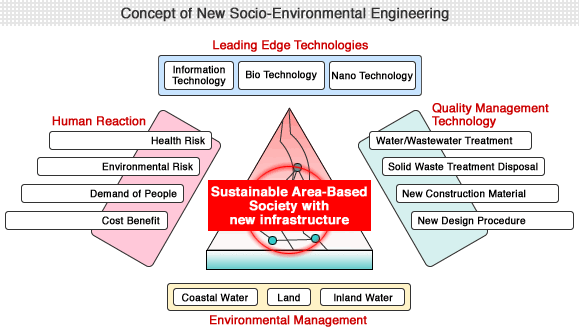Program Overview

Program Leader : Prof Yoshimasa Watanabe

 Professor of Hokkaido University Graduate School of Engineering
Professor of Hokkaido University Graduate School of EngineeringLab of Water Quality Control Engineering
| Yoshimasa WATANABE |
Research Assignment:
・Leading edge water treatment system
・Risk evaluation and control of toxic materials in the water environment
・Risk evaluation and control of toxic materials in the water environment

In 2003, Hokkaido University applied to the Ministry of Education, Culture, Sports, Science and Technology for a 21st Center of Excellence (COE) Program in the field of "mechanical, civil, architectural and other engineering." The project, entitled "Sustainable Water and Waste Metabolism System for Watersheds" (focus leader: Yoshimasa Watanabe) was subsequently adopted as a 2003 COE Program project.
Building sustainable water/waste metabolic systems for watersheds will require the creation of many new civil engineering technologies. Some of them are: new state-of-the-art water management systems to provide safe water supplies and provide uses for recycled sewage and waste water; resource recycling technology for the creation of urban mines and urban forests; appropriate treatment and disposal methods for non-recyclable waste products; new long-life materials to reduce generation of waste construction materials; and repair and reinforcement technology to lengthen the lifespan of construction materials. Also necessary will be the development of new management systems that take into consideration health benefits and risk, environmental benefits and risk, resource and energy production and consumption, timescales and consensus formation methods.
This COE project is a program to foster researchers and engineers who can create a social infrastructure system based on the holonic path concept (striving for the harmony of the whole while respecting the autonomy of the individual) for the planning, building and operation of a transport and quality improvement system for water and waste in a watershed. The system must be autonomous and decentralized and must be designed on an appropriate temporal and spatial scale.
Building sustainable water/waste metabolic systems for watersheds will require the creation of many new civil engineering technologies. Some of them are: new state-of-the-art water management systems to provide safe water supplies and provide uses for recycled sewage and waste water; resource recycling technology for the creation of urban mines and urban forests; appropriate treatment and disposal methods for non-recyclable waste products; new long-life materials to reduce generation of waste construction materials; and repair and reinforcement technology to lengthen the lifespan of construction materials. Also necessary will be the development of new management systems that take into consideration health benefits and risk, environmental benefits and risk, resource and energy production and consumption, timescales and consensus formation methods.
This COE project is a program to foster researchers and engineers who can create a social infrastructure system based on the holonic path concept (striving for the harmony of the whole while respecting the autonomy of the individual) for the planning, building and operation of a transport and quality improvement system for water and waste in a watershed. The system must be autonomous and decentralized and must be designed on an appropriate temporal and spatial scale.

